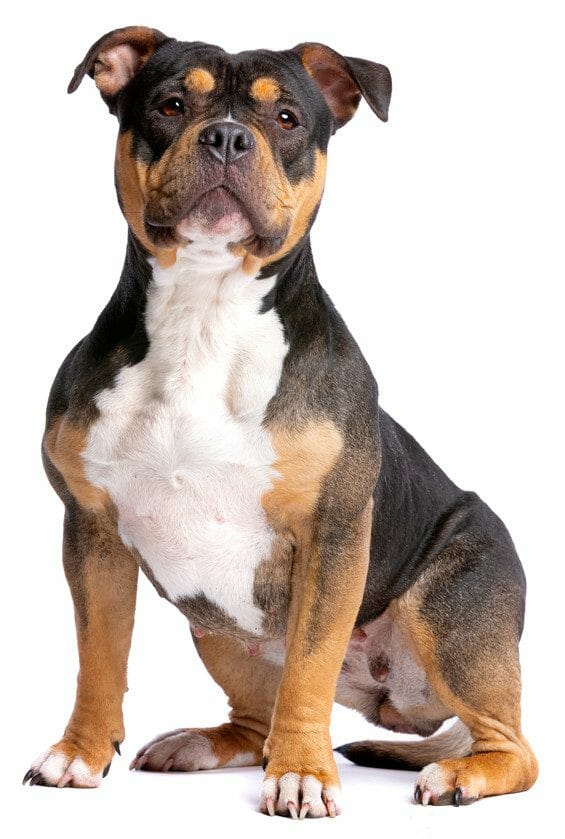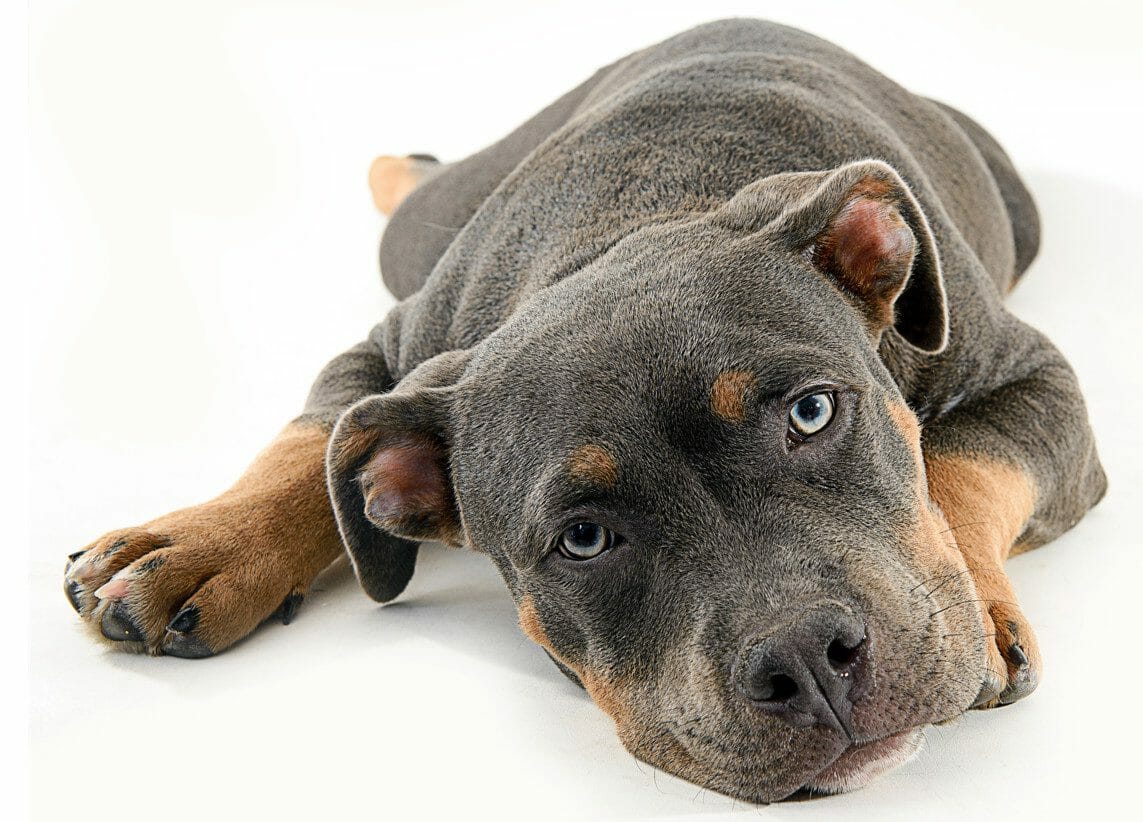American Bully

American Bully Temperament
The American Bully is an adaptable companion dog. Bred from the American Pit Bull Terrier, this dog breed does have a reputation for aggression. However, given the right training and environment, it can be a sweet and affectionate family pet.
Because the breed is descended from working dogs, it is easy to train the these canines. Use positive reinforcement to reward good behavior and never show any aggression. Although they get along well with children, owners should never leave their children unsupervised around this type of dog.

What Does an American Bully Dog Look Like?
The American Bully bears more than a passing resemblance to American Pit Bull Terriers, from which they are descended. These well-built dogs have a heavy neck, strong, muscular shoulders, and a back that slope towards the tail. Its chest is broad, and its straight legs are short compared to its size.
The heads of American Bullies are medium in length with well-defined cheeks, wide skulls, and high ears. The ears may be cropped or not. (However, in many countries, ear cropping is illegal.) The eyes and nose can be any color. Muzzles should be rounded at the top. The strong jaw gives an indication of the power of this dog’s bite. Lips should be even, and both arches of teeth should meet tightly.
American Bully Colors
The American Bully’s coat is stiff, short, and glossy and comes in a variety of colors:
- White
- Gray
- Black
- Blue
- Tan
- Brown
- Fawn
- Piebald
- Red

American Bully Sizes
The breed comes in a variety of sizes:
- American Bully XL: The largest male Bully stands at 21 to 23 inches, with females between 19 and 22 inches.
- Standard American Bully: Males are 17 to 20 inches, and females are 16 to 19 inches.
- American Bully Classic: These are the same size as the standard Bully but have a lighter frame.
- Pocket American Bully: Males are 14 to 17 inches and females are 13 to 16 inches.
American Bully History
The development of the breed now known as the American Bully began in the 1980s. However, it would be the 1990s before the dog’s personality and distinctive look would be achieved.
The aim was to create a dog with a lower prey drive and more of a “bully” personality and appearance in comparison to the American Staffordshire Terrier. Body mass and a heavier bone structure were sought, which has resulted in a dog with a wider front.
Several breeds went used to make the Bully. The American Pit Bull Terrier was the foundation, and the American Bulldog, English Bulldog, Olde English Bulldogge, and the American Staffordshire Terrier were used to fine-tune its temperament and physique. Different strains of American Pitbull Terrier were used throughout the process to arrive at a stockier build that was clearly different from existing breeds.
In 2004, the American Bully Kennel Club (ABKC) recognized the breed, and the first standard for the breed was created. However, the breed is not currently recognized by either the American Kennel Club or The Kennel Club.

American Bully vs American Staffordshire Terrier
The American Bully is roughly the same size as the AmStaff but is considerably heavier. A Bully is typically easier to train than an American Staffordshire Terrier.
American Bully vs Staffordshire Bull Terrier
The British Staffordshire Bull Terrier was brought to the United States in the 19th century and was adapted by breeders looking to improve its fighting abilities. Because of this, this breed most likely shares some of its genes.
American Bully vs American Pit Bull Terrier
The American Pit Bull Terrier is the breed on which the American Bully was established. Breeders sought to reduce the aggression associated with the pit dogs, which were previously bred for fighting.
Bull Terrier vs American Bully
With its distinct triangular eyes, the Bull Terrier looks like no other dog. Bull Terriers are taller but lighter than the American Bully.

American Bully Lifespan
The lifespan of the breed ranges between 10 and 13 years. Taking the following steps will help to ensure these canines enjoy and long and healthy life.
- Provide regular checkups with a vet
- Vaccinate the dog with all recommended vaccines (such as rabies and parvo)
- Use preventive medications for fleas, ticks, and heartworms
- Feed the dog a healthy and nutritionally balanced diet
- Provide daily walks and exercise that do not overexert the dog.

American Bully Health Issues
This modern breed is genetically predisposed to several health conditions. Because of the newness of the breed, testing for genetic health concerns is not as commonplace as it is in more established breeds.
- Brachycephalic Respiratory Syndrome. Due to the shortness of its muzzle, these canines are prone to breathing problems that make it hard for these dog to regulate their own temperature. It also puts a dog at a higher risk of developing problems with its eyes and teeth.
- Cherry Eye. Cherry eye is the more commonly used name for a prolapsed gland of the nictitans. This occurs when the tear gland within a dog’s third eyelid becomes inflamed—causing a swollen, red mass to appear in the corners of the eye. The condition is very easy to spot and typically occurs in younger dogs. Cherry eye can be repaired surgically. Untreated, the condition may result in conjunctivitis.
- Entropion. When a dog’s eyelid rolls inward, it causes entropion. The hairs on the surface of the eyelid cause irritation and can damage the surface of the eye. Treatment usually involves surgery to correct the problem. If the condition is not caught and treated promptly, ulceration may occur on the eye, and the dog’s eyesight may be affected.
- Ectropion. Ectropion is another condition that affects the eyes of the dog. This time the lower eyelid turns outward and appears droopy. When this happens, the conjunctival tissue surrounding the eye is exposed, which can become dry and irritated. Eye drops and surgical correction are used to treat the condition.
- Hip Dysplasia. Hip dysplasia is a genetic condition that can cause lameness. As the dog’s bones grow, the two halves of the hip joint develop at different rates. This can make the bones grind against each other making it harder to walk. Usually, hip dysplasia will affect a dog while it is still young. Treatment for this condition will involve corrective surgery.
- Elbow Dysplasia. A similar condition to hip dysplasia can affect the elbow joints of younger dogs. Variations in the way that parts of the elbow develop can cause pain or lameness in the joint. Again, the best course of action is for the dog to undergo surgery.

